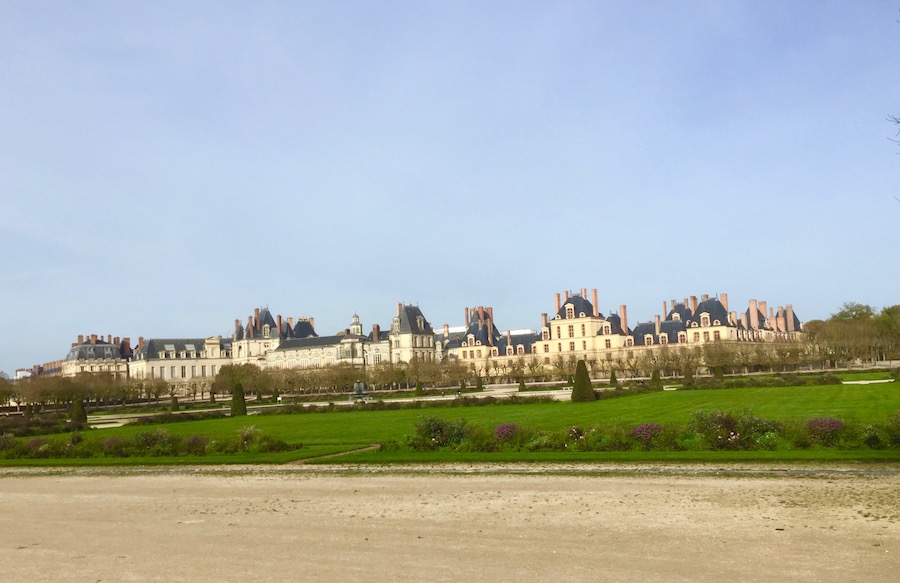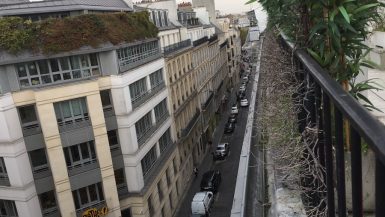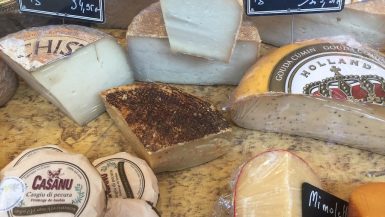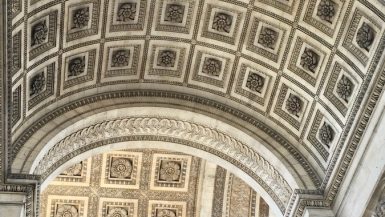November 1, 2017
The baguette and jam for breakfast fortified me for my latest adventure ~ a day trip outside of Paris. I made my way to the metro and found the RER, which would take me to Gare de Lyon, one of the many large train stations in Paris. I’d never been to Gare de Lyon, so I was unfamiliar with its layout, which was further complicated by a lot of construction.
I set off in one direction looking for the ticket window only to find it was closed and in one of the construction areas. Looking at the board with all the trains leaving in the next hour let me know there were a few going in my direction (based on the information I’d pulled from the internet). But, I didn’t have a ticket.
I found a security guard, who pointed me toward one of the platforms; however, when I mentioned (part in French, part in English) that I didn’t yet have a ticket, he sent me back downstairs. The only ticket window open was located a few steps from where I’d gotten off the RER.
I only had a few minutes before the first train left but there was a line at the window. The first train left without me. When it was finally my turn, the woman was pleasant (most ticket people here are not), but slow. She tried to convince me a several day pass would be better since I was going to be in Paris a few more days. I told her I only needed the day pass for zones 1-5 because I already had some inner city metro tickets left from a previous purchase. She didn’t seem to agree with me; I finally got my way.
Then it was back upstairs to wait by the monitor to see from which track my train would leave. Not sure why, but even if the station knows what track a train will leave from, they don’t post it until minutes before the train leaves. Then you have to hope it isn’t the furthest one away and run to it. Connections can be really tight and anxiety-ridden.
My train was scheduled to leave at 9:20 a.m.; they posted the Hall (Gare de Lyon has three halls, making things even more complicated) and track number at about 9:08 a.m. I sprinted off in the correct direction (I’d had time to scope out the layout) and, of course, I was on the furthest track. I made the connection with 4 minutes to spare.

Four stops and 42 minutes later, I arrived at the Fontainebleau-Avon station. I followed a group of people who looked like they might know where they were going. Luckily for me, a city bus had just pulled up to the bus stop. I checked it was Ligne 1 (info from the internet) and hopped on, verifying my ticket in the machine on board, just like I knew what I was doing.
About nine stops later, the bus driver bellowed “Chateau,” and I got off. Unfortunately, there was no sign directing my next move. I could tell I was standing outside the walls of an enormous Château/palace but didn’t see an unlocked entrance. Do I go left? Do I go right? There were no big crowds to follow as there had been at Versailles, so which way to go? I pulled up my big girl panties and gambled on going left.

I passed by several closed entrances and finally found an open gate. It didn’t lead me to the Château itself but led me into its extensive gardens. I usually like to explore inside first and then go out to the garden, but since I was there, I decided to mix it up.
While all the trees had lost their leaves and most of the flowers had lost their bloom, the gardens had a wild, mystical look to them. All the fountains were on, and there were ducks and geese everywhere, even a few swans. I watched as a family of Canada geese waddled out of one fountain, grazed on grass as they went, and got into a different fountain.
Everything looked very comfortable and lazy. And there were hardly any people. This was so unlike the crowds of people we encountered at Versailles. I estimate that I only saw 150-200 people the entire time I was at the Château.
Fontainebleau was originally built in the Middle Ages (1137) by Louis VII, but only a small part of that palace remains. It really started to take shape in the 16th century, when King Francois I began to rebuild. It became a favorite residence and hunting lodge of the Kings of France. King Henry II (and Catherine de’ Medici) added the royal apartments, grand ballroom, and sweeping horseshoe-shaped staircase. King Henry IV added even more rooms, wings, and galleries in the 17th century and also expanded the gardens around the palace.
The 18th century found King Louis XV expanding the galleries and adding a large pavilion. Later on, Emperor Napoleon, King Louis-Philippe and Emperor Napoleon III (and Empress Eugenie) would each inhabit the palace and add a personal touch. The interior design blossomed under Napoleon III’s watch. Fontainebleau was where Napoleon spent the last few days of his reign before abdicating in 1814.
The palace is huge and goes on and on for days. There are over 1500 rooms and 130 acres of parkland and gardens. Unfortunately, several portions of the palace are under construction and restoration and I couldn’t visit, but what I could visit was beautiful. I recommend getting the audio/visual guide for an extra 3 euros (the regular entrance fee is 11 euros).
The interior decoration of the rooms is phenomenal and over the top, but not in a gaudy ultra-gold manner (like Versailles). Well, don’t get me wrong, there is still a lot of gold. Some of the ceilings are out of this world.
Of all the palaces, castles, and chateaus I’ve visited on this trip, I think this is my favorite. I believe it would be even more spectacular in the spring when everything is in bloom.

I did the interior tour at a slow pace. I like to read everything, listen to everything on the audio, and look at all the fine details of paintings and tapestries. Afterward, I returned to the gardens to sit on a bench near one of the large ponds to people watch and watch the ducks, geese, and swans. It was very serene – well, except for the ear piercing excited screams of little children while they threw scraps of bread (or something) at the ducks (and pigeons).
Five hours after I arrived, I made my way out to the bus stop to retrace my steps. Bus 1 back to the Fontainebleau-Avon station ~ check.

A train going in the direction of Gare de Lyon ~ check. Make my way through the vastness of Gare de Lyon to the Metro/RER ~ check. Find the RER A ~ well, kind of a check.
Sometime during the day, there was an accident along the RER A route, which had closed down several stops and traffic was spotty along the line. Announcements were being made (only in French), and people wandered around like they weren’t sure where to go. I figured out that the line was shut down at the Auber station, which was fine by me as that was my destination anyway.
I jumped on the next RER A train, got off at Auber, made my way through the underground tunnels, and took the stairs up top where the Opera House rose up to greet me. Down around a corner and I was back to my hotel – another successful adventure. Just like I knew what I was doing.
Only two more days in Paris, and then I return home.





























